Hydrangea,
Buddleja and Polka Weigela
Life Cycles Near Our Cottage
Bob Jensen at
Trinity University
Up here in the White Mountains, most of our perennial hydrangeas begin as white "mop
heads" that
after a couple
of months commence to change to "dirty pink" or "dirty green"
But we also have bright orange, light blue, and sometimes purple mop heads
Some hydrangea plants are bushes and others are more like small trees laden with
drooping mop heads
This is one of the best shots I captured of the orange hydrangeas
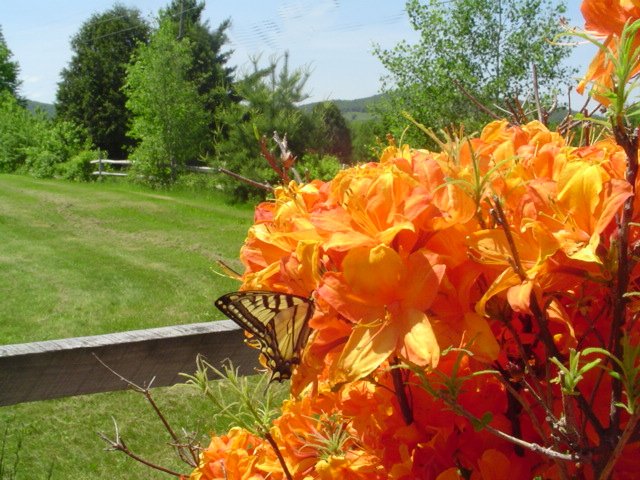
Belowis the hydrangea tree over our well casing
The amazing thing to me is how hydrangea mop heads can take our high winds
When other blossoms come loose in a gale-force wind, the hydrangea mop heads
will usually hang on
Below you can see our white hydrangea tree contrasted with our red New Guinea
Impatiens
From my desk
Hydrangea --- http://en.wikipedia.org/wiki/Hydrangea
Hydrangea common names Hydrangea and Hortensia) is a genus of about 70 to 75 species of flowering plants native to southern and eastern Asia (China, Japan, Korea, the Himalayas, and Indonesia) and North and South America. By far the greatest species diversity is in eastern Asia, notably China, Japan, and Korea. Most are shrubs 1 to 3 meters tall, but some are small trees, and others lianas reaching up to 30 meters by climbing up trees. They can be either deciduous or evergreen, though the widely cultivated temperate species are all deciduous.
Having been introduced to the Azores Islands of Portugal, they are now very common there, particularly on Faial, which is known as the "blue island" due to the vast number of hydrangeas present on the island, Terceira, named the "lilac island" for hydrangeas of that colour, on Flores Island ("Island of Flowers") and São Miguel, named the "green island" for its floral biodiversity.
Species in the related genus Schizophragma, also in Hydrangeaceae, are also often known as hydrangeas. Schizophragma hydrangeoides and Hydrangea petiolaris are both commonly known as climbing hydrangeas.
There are two flower arrangements in hydrangeas. Mophead flowers are large round flowerheads resembling pom-poms or, as the name implies, the head of a mop. In contrast, lacecap flowers bear round, flat flowerheads with a center core of subdued, fertile flowers surrounded by outer rings of showy, sterile flowers. The flowers of some rhododendrons can appear similar to those of some hydrangeas, but Rhododendron (including azalea) is in a different order.
Colors and soil acidity
Hydrangea flowers are produced from early spring to late autumn; they grow in flowerheads (corymbs or panicles) at the ends of the stems. In many species, the flowerheads contain two types of flowers, small fertile flowers in the middle of the flowerhead, and large, sterile bract-like flowers in a ring around the edge of each flowerhead. Other species have all the flowers sterile and of the same size.
Colors and soil acidity
In most species the flowers are white, but in some species (notably H. macrophylla), can be blue, red, pink, light purple, or dark purple. In these species the color is affected by the pH of the soil; acidic which can be taken up into hyperaccumulating plants.[For H. macrophylla and H. serrata cultivars, the flower color can be determined by the relative acidity of the soil: an acidic soil (pH below 6) will usually produce flower color closer to blue, whereas an alkaline soil (pH above 6) will produce flowers more pink.
The majority or white hydrangeas in these mountains change to a dirty pink in
September
This is because of the change in petal colors to pink mixed with brown as winter
approaches
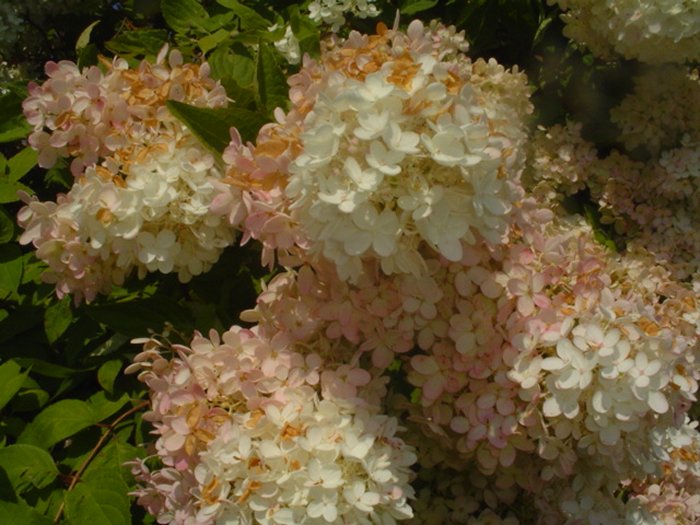
Each year I trim the hydrangea tree over the well casing so it does not
eventually block our White Mountain views
In our back yard, I transplanted this spruce tree and this hydrangea bush too
close to one another
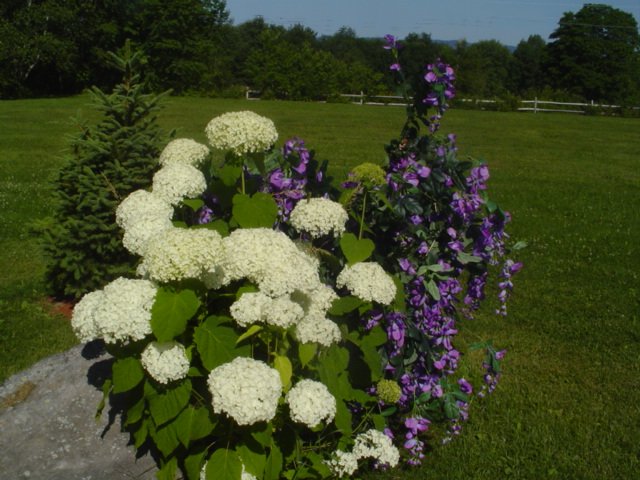
As the above hydrangea bush ages, the mop heads turn green instead of dirty pink
in September
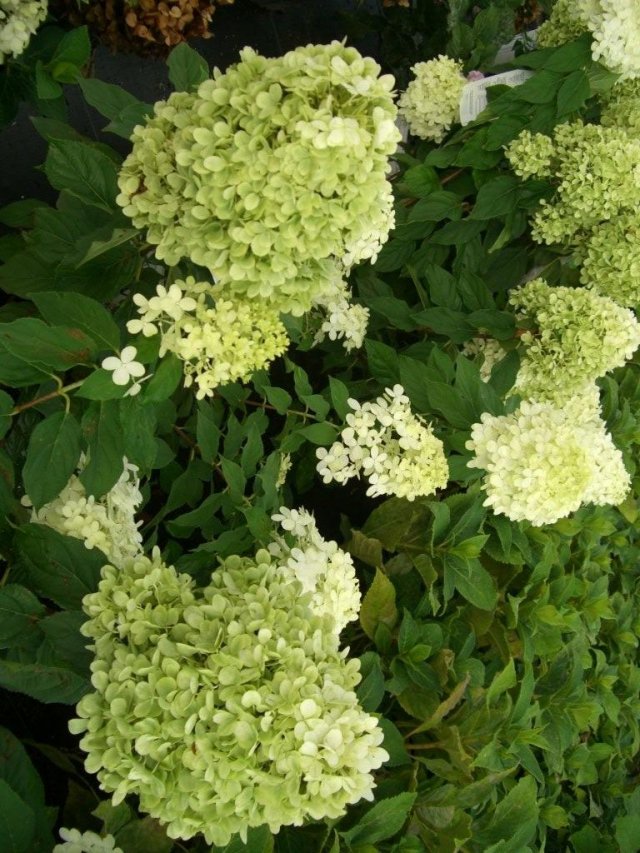
Some of our hydrangeas are also blue
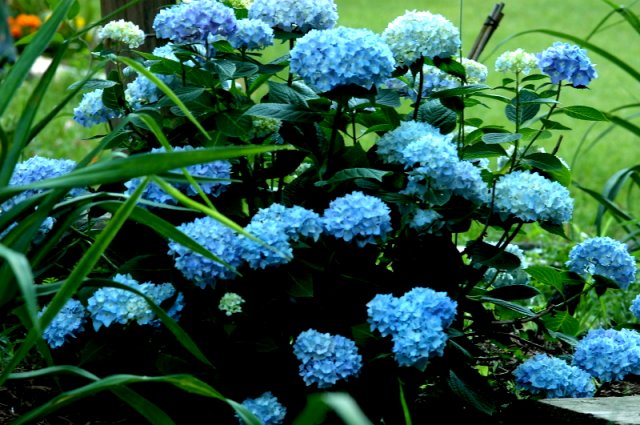
Among my favorite hydrangeas are the orange hydrangeas in the back
The good news is that these bloom earlier than the other hydrangeas
The bad news is that the orange hydrangeas are flashes in the pan
Whereas most of the other hydrangeas bloom for over three months
The orange hydrangeas barely make it for two weeks
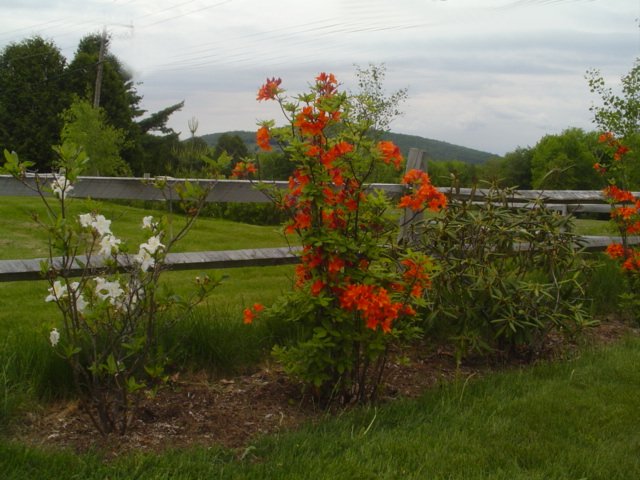
I put mirrors on my tractor last autumn so I could blow snow driving in reverse
Our other orange flowers are lillies
The golf course behind our house has an old orange tractor
Butterfly Bush --- http://en.wikipedia.org/wiki/Buddleja
Buddleja, or Buddleia commonly known as the butterfly bush,[4] is a genus of flowering plants. The generic name bestowed by Linnaeus posthumously honoured the Reverend Adam Buddle (1662–1715), a botanist and rector in Essex, England, at the suggestion of Dr. William Houstoun. Houstoun sent the first plants to become known to science as buddleja (B. americana) to England from the Caribbean about 15 years after Buddle's death.
I only have one butterfly bush remaining beside the pond
It looks a lot like a hydrangea bush
It truly does attract an unbelievable number of butterflies
This is a picture facing west toward Vermont
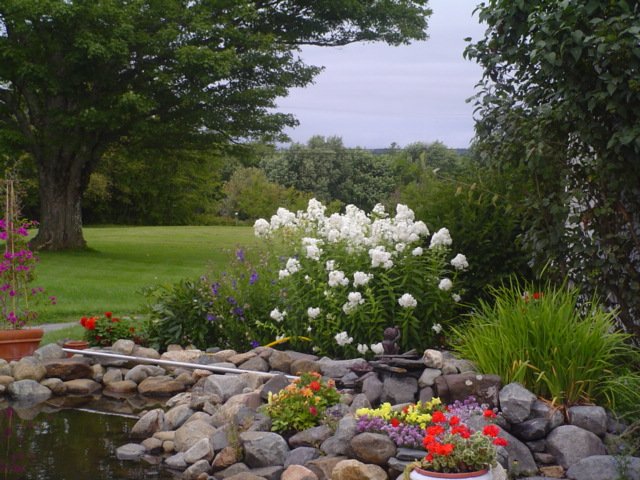
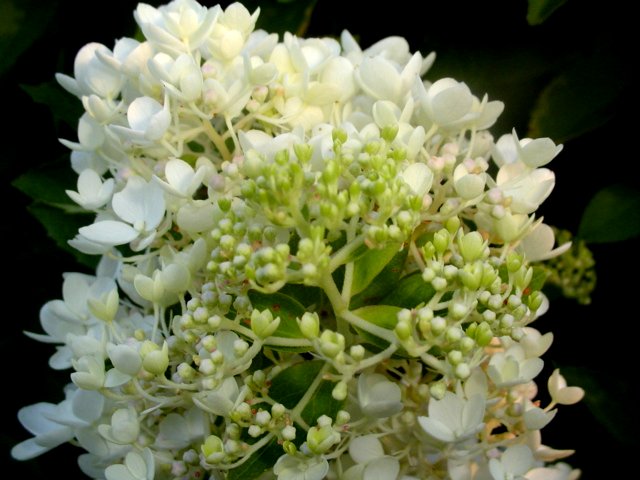
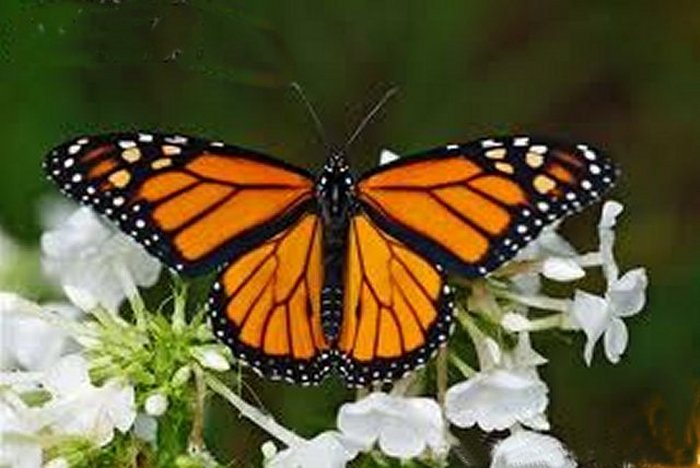
One other flowering bush beside our pond is the Polka Wegeila
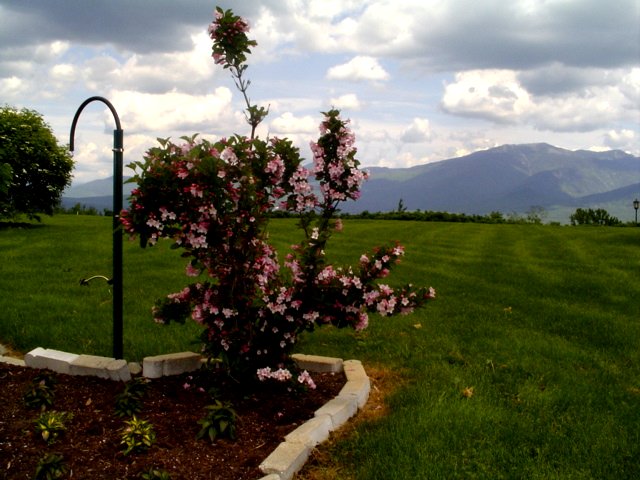
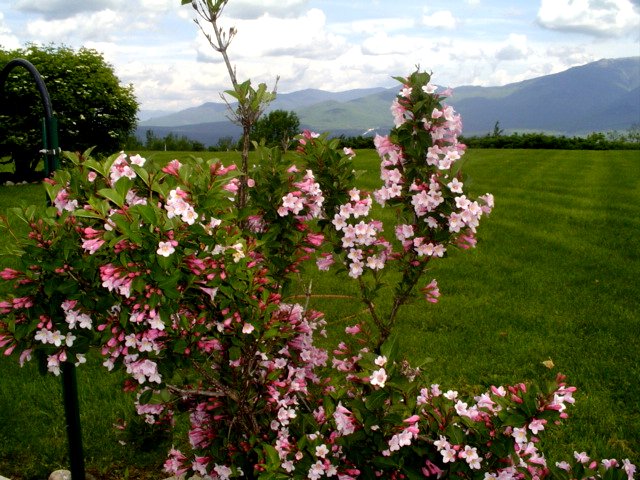
The good news
about living in the country is that there are no water and sewer bills
The bad news is that you must have a deep well and quality septic system
And with a septic system comes an underground tank pump out about every two
years
Up here in the mountains this pump out costs us about $350 each time we
have the tank cleaned out
The truck below hauls cold beer when septic tank business is slow
Just kidding of course!
More of Bob Jensen's Pictures and
Stories
http://www.trinity.edu/rjensen/Pictures.htm
WhiteMountainHistory.org ---
http://whitemountainhistory.org/
Over 70 Historical Photographs ---
http://photos.whitemountainhistory.org/AlbumHomeView.aspx
Blogs of White
Mountain Hikers (many great photographs) ---
http://www.blogger.com/profile/02242409292439585691
Especially note
the archive of John Compton's blogs at the bottom of the page at
http://1happyhiker.blogspot.com/
AMC White Mountain Guide: Hiking Trails in the White Mountain National
Forest ---
http://books.google.com/books/about/AMC_White_Mountain_Guide.html?id=V6-hFq6yHcAC
Find Hiking Trails --- http://www.traillink.com/?gclid=CPPLy8-wt7ECFYNx4AodR2QAsQ
Seven Mile Ford Farm (Wes Lavin) ---
http://www.facebook.com/media/set/?set=a.696607201622.2152004.20102311&type=3&l=2d76bf4dc6
Photographs of Vergennes (Oldest Village in Vermont) http://cdi.uvm.edu/collections/getCollection.xql?pid=bixby
Historic Barn Etchings Tell Tale of
Hard-Working Children ---
Click Here
http://www.openculture.com/2012/06/historic_barn_etchings.html?utm_source=feedburner&utm_medium=email&utm_campaign=Feed%3A+OpenCulture+%28Open+Culture%29
What Goes on in a Garden? --- http://www.youtube-nocookie.com/embed/xHkq1edcbk4?rel=0
Photographs of Vergennes (Oldest Village in Vermont) http://cdi.uvm.edu/collections/getCollection.xql?pid=bixby
Historic Barn Etchings Tell Tale of
Hard-Working Children ---
Click Here
http://www.openculture.com/2012/06/historic_barn_etchings.html?utm_source=feedburner&utm_medium=email&utm_campaign=Feed%3A+OpenCulture+%28Open+Culture%29
On May 14,
2006 I retired from
Trinity University after a long and
wonderful career as an accounting professor in four universities. I was
generously granted "Emeritus" status by the Trustees of Trinity University. My
wife and I now live in a cottage in the White Mountains of New Hampshire ---
http://faculty.trinity.edu/rjensen/NHcottage/NHcottage.htm
Bob Jensen's Blogs
Current and past editions of my newsletter called New
Bookmarks ---
http://faculty.trinity.edu/rjensen/bookurl.htm
Current and past editions of my newsletter called
Tidbits ---
http://faculty.trinity.edu/rjensen/TidbitsDirectory.htm
Current and past editions of my newsletter called Fraud
Updates ---
http://faculty.trinity.edu/rjensen/FraudUpdates.htm
Bob Jensen's past presentations and lectures
---
http://faculty.trinity.edu/rjensen/resume.htm#Presentations
Our cottage was known as the Brayton Cottage in the early 1900s
Sunset Hill is a ridge overlooking with
New Hampshire's White Mountains to the East
and Vermont's
Green Mountains to the West
Bob Jensen's Threads --- http://www.trinity.edu/rjensen/threads.htm
Bob Jensen's Home Page --- http://www.trinity.edu/rjensen/